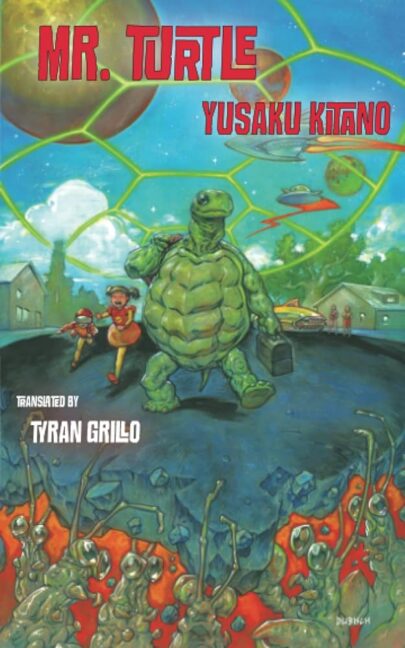By YUSAKU KITANO (Kurodahan Press; 2017)
This is certainly among the weirdest books put out by the late Kurodahan Press. The subject is a cyborg turtle, constructed as an instrument of war, in a Japanese import that functions as a bizarre speculative narrative, a philosophical fable and a surreal mind-tugger. I’d like to report the mixture is an unqualified success, but that’s simply not the case. I found the book extremely uneven, which may be the fault of the English translation by Tyran Grillo, who admits in an introduction that his job was an arduous one.
The opening passages detail the day-to-day problems faced by the non-speaking Kame-Kun, “a REPLICAN(T)URTLE” who views the world in terms of shells and what lies in and outside them. His exploits, which include renting an apartment, trying to get a library card and interviewing for a job, are quite mundane, intended to show his wobbly integration into Japanese society. This sort of thing was already done in THE MAN WHO FELL TO EARTH and DYING INSIDE, and if I hadn’t already read those novels I might have enjoyed this one more, as they did the nonhuman-consciousness-adapting-to-human-existence angle better.
Another problem is that the future world in which Kame-Kun lives is shockingly bland. That’s despite potentially intriguing elements like human-sized animals existing side-by-side with people, turtle shells utilized as hip teenage girl accessories (a concept that ultimately goes nowhere) and a “Tower of Progress” built during wartime that’s been turned into an interactive museum. As for the copious pop culture references, which include POKEMON and Thomas the Tank Engine, they’re straight out of the early aughts (which severely dilutes the “future” vibe). Further references are made to PINOCCHIO and Philip K. Dick’s DO ANDROIDS DREAM OF ELECTRIC SLEEP?, which is discussed at some length as, presumably, a corollary to the protagonist’s dilemma.
It’s the Tower of Progress that initially triggers Kame-Kun’s memories of his time on Jupiter, where robot turtles were tasked with fighting a war—waged against “super crayfish”—in place of humans. The novel grows increasingly hallucinatory as dreams intrude on the narrative and Kame-kun prepares for hibernation; these passages have a wildly surreal pull, with a vagueness may or may have been due to the quality of the English translation.
MR. TURTLE has enough interesting elements to warrant a recommendation. It’s certainly unique and easy to read, but streamlined and cohesive it isn’t.

